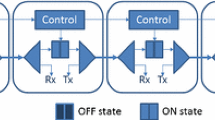Abstract
We design and analyze communication algorithms for an optical switch based on the electroholographic effect, that provides capabilities for configuration changes and a limited multicast. As configuration changes incur a high overhead, we suggest the use of a high-speed forwarding unit as part of the network interface. We develop broadcast algorithms that trade off the number of configuration changes and forwarding operations in order to achieve the minimal completion time. For general point- to-point communication, we use the limited multicast to create a spanning topology along which messages can be forwarded. This requires care to avoid collisions, but is still preferable to using configuration changes if the topology is rich enough but still has a low degree.
Similar content being viewed by others
References
A. Agranat, V. Leyva, and A. Yariv. Voltage-controlled photorefractive effect in paraelectric KTa1-xNbxO3:Cu,V. Opt. Lett., 14(18):1017–1019, September 1989.
A. J. Agranat, G. Bartal, J. Krupnic, B. Pessah, and D. Sadot. The electroholographic optical switches and interconnects. In E. Marom et al., eds., Unconventional Optical Elements for Information Storage, Processing and Communications, pp. 235–239, Kluwer Academic Publishers, 2000.
B. W. Arden and H. Lee. Analysis of chordal ring network. IEEE Trans. Comput., C-30(4):291–295, Ap. 1981.
A. Barak and E. Schenfeld. Embedding classical communication topologies in the scalable OPAM architecture. IEEE Trans. Parallel & Distributed Syst., 7(9):979–992, September 1996.
S. M. Bhandarkar and H. R. Arabnia. Parallel computer vision on a reconfigurable multiprocessor network. IEEE Trans. Parallel & Distributed Syst., 8(3):292–309, March 1997.
I. Elhanany, J. Nir, and D. Sadot. A contention-free packet scheduling scheme for provision of quality-of-service in Tbit/sec WDM networks. Optical Networks, 1(3):1–6, July 2000.
P. Green, Optical networking update. IEEE J. Selected Areas Commun., 14(5):764–779, 1996.
A. Jourdan, F. Masetti, M. Garnot, G. Soulage, and M. Sotom. Design and implementation of a fully reconfigurable all-optical crossconnect for high capacity multiwavelength transport networks. J. Lightwave Technology, 14(6):1198–1206, June 1996.
M. Kumar and Y. Baransky. The GF11 parallel computer: programming and performance. Future Generation Comput. Syst., 7(2&3):169–179, April 1992.
B. Mans. On the interval routing of chordal rings. In Zomaya, Hsu, Ibarra, Horiguchi, Nassimi, and Palis, eds., Int'l Symp. Parallel Architectures, Algorithms & Networks, pp. 16–21, IEEE, June 1999.
D. S. Meliksetian and C. Y. R. Chen. Optimal routing algorithm and the diameter of the cubeconnected cycles. IEEE Trans. Parallel & Distributed Syst., 4(10):1172–1178, October 1993.
A. G. Nowatzyk and P. R. Prucnal. Are crossbars really dead? The case for optical multiprocessor interconnect systems. In 22nd Ann. Intl. Symp. Computer Architecture Conf. Proc., pp. 106–115, June 1995.
B. Pesach, G. Bartal, E. Refaeli, A. J. Agranat, J. Krupnik, and D. Sadot. Free-space optical crossconnect switch by use of electroholography. Applied Optics, 39(5):746–758, February 2000.
R. Sabella, E. Iannone, and E. Pagano. Optical transport networks employing all-optical wavelength conversion: limits and features. IEEE J. Selected Areas Commun., 14(5):968–978, June 1996.
R. Sivaram, D. K. Panda, and C. B. Stunkel. Efficient broadcast and multicast on multistage interconnection networks using multiport encoding. IEEE Trans. Parallel & Distributed Syst., 9(5):1004–1028, October 1998.
L. Snyder. Introduction to the configurable, highly parallel computer. Computer, 15(1):47–56, January 1982.
B. Webb and A. Louri. A class of highly scalable optical crossbar-connected interconnection networks (SOCNs) for parallel computing systems. IEEE Trans. Parallel & Distributed Syst., 11(5):444–458, May 2000.
T. Yoshikawa and H. Matsuoka. Optical interconnections for parallel and distributed computing. Proc. IEEE, 88(6):849–855, June 2000.
Author information
Authors and Affiliations
Rights and permissions
About this article
Cite this article
Er-El, D., Feitelson, D.G. Communication Models for a Free-Space Optical Cross-Connect Switch. The Journal of Supercomputing 27, 19–48 (2004). https://doi.org/10.1023/A:1026294721704
Issue Date:
DOI: https://doi.org/10.1023/A:1026294721704




